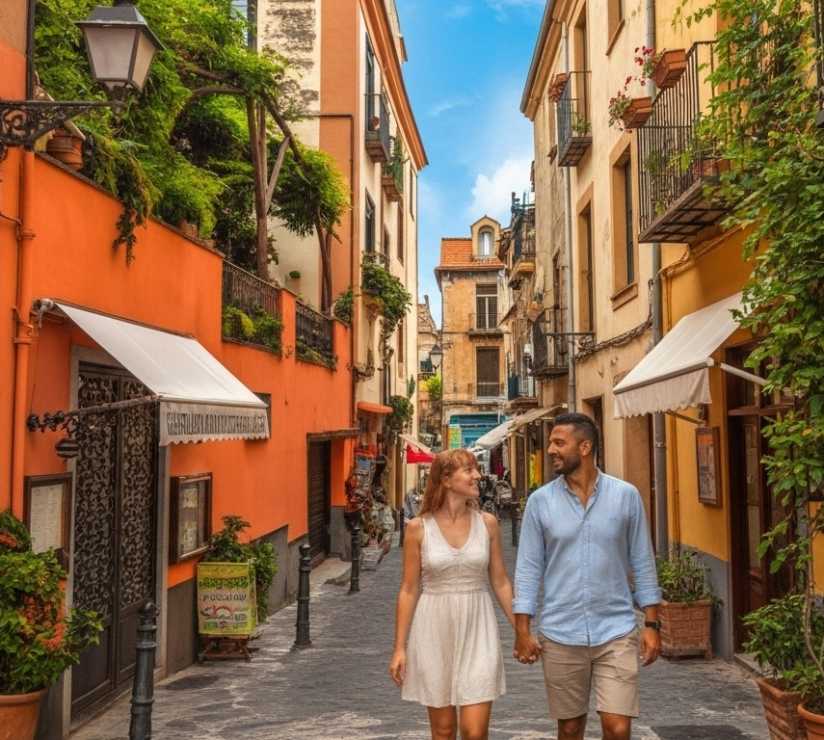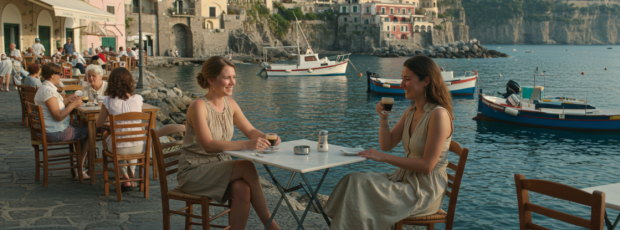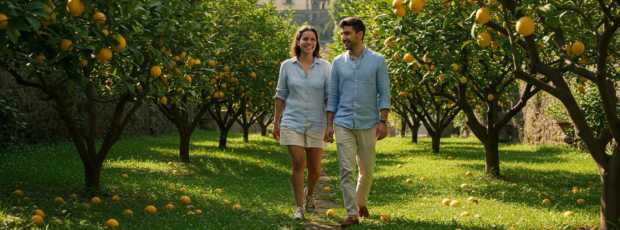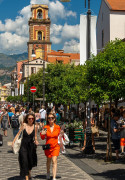Our tour was exceptional. Stella was outstanding. We gained a significant amount of knowledge from Stella and she was delightful to be around.Richard H, Sorrento, 2025
Table Of Contents
- What Are Sorrento's Real Everyday Gems?
- Where to Find Sorrento's Cultural and Creative Gems?
- What Food and Drink Gems Do Locals Use?
- Which Neighborhood and Social Gems Matter to Locals?
- What Are Sorrento's Best Nature and Outdoor Gems?
- What "Fake Gems" Should You Actually Skip or Tweak?
- What Practical Tips Help You Navigate Like a Local?
- Frequently Asked Questions
- Why Sorrento's Daily Life Beats Any Postcard
I'm Naples-born with a Sorrento obsession, and let me clear something up right away: locals don't call these places "secrets." They call them daily life.
When tourists ask me about lesser-known spots in Sorrento during my walks around this Sorrentine Peninsula town, I usually chuckle.
The places I'm about to share aren't whispered about because they're exclusive, they're just where Sorrento actually lives beyond the postcard shots.
These are truer 2025 "hidden gems," or at least genuinely quieter, local-first swaps filtered by access friction, local utility, and low marketing footprint.
After years of hosting visitors through these limestone streets and citrus groves, I know that the best Sorrento experiences aren't hiding at all. They're simply woven into the fabric of a working coastal town where fishing boats still matter more than photo ops, and Sunday lunch runs longer than any guidebook suggests.
What Are Sorrento's Real Everyday Gems?
These aren't attractions or just simple things to do in Sorrento, they're the corners Sorrento offers where locals actually live their daily routines.
Vicolo II Fuoro: Where Errands Beat Aesthetics
Most visitors stick to Corso Italia's main shopping stretch, but we like to slip down Vicolo II Fuoro for their real errands.
This narrow lane keeps Centro Storico human, you'll find artisan shops, a proper hardware store, and the kind of places where neighbors actually chat while picking up keys or getting shoes repaired.
The stones are uneven but step-free, and there's something refreshing about a street that exists for function over photos.
When I host walking experiences, I often detour here just to show what a living old town looks like when it's not performing for cameras.
Quick tip: Perfect for authentic shopping without the souvenir shop markup.
Want to Experience Sorrento Firsthand?
Step into the neighborhood, scene, or story with someone who knows it inside out.

Aperitivo table with friends
Piazza Tasso Edges: Aperitivo Time Done Right
Everyone photographs Piazza Tasso's center, but the real action happens at the edges between 18:30 and 20:00.
Locals don't camp in the middle, they claim tables at the perimeter cafés for their pre-dinner spritz and people-watching ritual. The square transforms from tourist crossroads to neighborhood social hub once aperitivo hour kicks in.
Order at your table after 18:30 (that's the etiquette), stick to a limoncello spritz or simple Aperol, and watch how Italy actually unwinds after work.
The conversations, the gestures, the way families with three generations somehow coordinate their evening walk – this is Piazza Tasso, Sorrento's real social theater.
Quick tip: Avoid the center tables; locals prefer the square's quieter edges for genuine aperitivo culture.
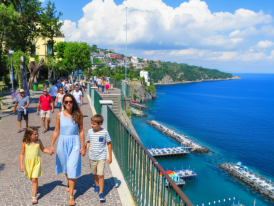
Villa Comunale and people taking a stroll
Villa Comunale Park and San Francesco: The Perfect Pause
I've seen how most tourists rush through Villa Comunale Park for a quick sea view snap, and I feel disappointed on their behalf.
See, we treat this green plateau as our outdoor living room. The benches here catch the best cross-breeze between the bay and the hills, especially during golden hour when the light turns everything honeyed.
Walk through the adjacent Chiostro di San Francesco (Cloister of San Francesco) too, it's not just a photo stop but an active civic space hosting weddings and evening concerts.
The acoustics are incredible, the 14th-century arches frame the bay perfectly, and it's one of the most step-friendly cultural sites in town.
When I bring groups here, we often catch locals reading newspapers on the Villa Comunale benches or elderly couples sharing gelato while watching the sunset paint the water. It's completely accessible and perfectly peaceful.
Quick tip: Time your visit for golden hour, and check the cloister for evening events – the music echoing through those medieval arches is unforgettable.
Where to Find Sorrento's Cultural and Creative Gems?
Skip the tour-group magnets; these cultural spots serve local pride first, visitors second.
Museo Correale di Terranova is rarely crowded, always cool, and offers genuine insight.
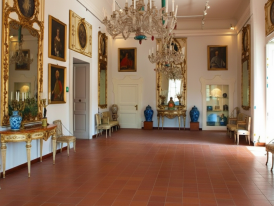
Gallery room at Museo Correale di Terranova
Museo Correale di Terranova: Local Pride Over Tourist Crowds
While everyone rushes to archaeological finds at Pompeii or Mount Vesuvius, this civic pride museum sits quietly overlooking the bay with barely a crowd.
We tend to rate Museo Correale di Terranova higher than most visitors do. It's packed with Sorrentine decorative arts, majolica, and the kind of regional cultural context that makes you understand why this particular coast shaped Italian craftsmanship.
The collection spans centuries of local artisans' work, from intricate wood inlays to delicate ceramics.
It's rarely crowded, always cool, and offers genuine insight into how Sorrento's creative DNA developed beyond just growing lemons.
Quick tip: Perfect rainy-day alternative with genuine local cultural depth instead of tourist-targeted exhibits.

San Francesco Cloister
San Francesco Cloister: Living Heritage, Not Just History
I mentioned the Cloister of San Francesco above, but it deserves its own spotlight as a cultural gem.
This isn't a dead monument, it's a living piece of Sorrento's social fabric where weddings happen on Saturday afternoons and classical concerts echo through summer evenings.
The 14th-century architecture creates natural acoustics that locals have used for centuries. When you visit, you might catch rehearsals, stumble into art installations, or simply enjoy the quiet that comes from truly thick stone walls blocking out the coastal bustle.
Quick tip: Check local event listings – experiencing live music in these ancient arches beats any regular concert hall.
Curious What You Won’t Find Online About Sorrento?
Discover the side only locals talk about.
See how it works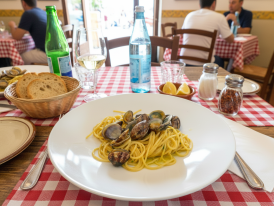
Simple plate of spaghetti alle vongole
What Food and Drink Gems Do Locals Use?
Forget the Instagram food tours; here's where locals eat when they're hungry.
Marina Grande: Sunday Long Lunch with the Fishing Fleet
Marina Grande isn't a hidden gem, it's a working fishing village that happens to serve the best fresh fish lunch in Sorrento.
But here's what guides miss: locals come here for specific rituals, especially weekend-long lunch sessions that stretch from noon to 4 PM while watching actual fishing boats unload their catch.
Skip the glossy menus right on the quayside (those are for quick tourist meals) and ask for simple preparations, fried fish, pasta alle vongole, whatever came in that morning.
If they push a long tasting menu, I ask what came off the boats. If they hesitate, I walk. The portions are generous, the prices reflect you're paying for waterfront dining, and the atmosphere is authentic working-port Italy, not staged Mediterranean charm.
When I host food walks, this is where we end up for the real what to eat in Sorrento experience, focusing on the town's fishing culture, not just its lemon reputation.
Quick tip: Reserve weekend tables, bring cash for smaller places, and embrace the slow Italian lunch pace.
Caseificio "Il Turuziello": Mozzarella-Making in Rural Setting
In Schiazzano, Massa Lubrense, there is a family farm that offers mozzarella-making demonstrations and tastings that fold in PGI lemon grove context through small-group, rural experiences with low tourist churn. I highly recommend a stop at Azienda Agrituristica Il Turuziello.
You'll understand the connection between local dairy traditions and the agricultural landscape that defines this peninsula.
The demos show traditional cheese-making techniques passed down through generations, while tastings include fresh mozzarella, ricotta, and other dairy products made on-site.
The lemon grove setting provides an agricultural context that connects dairy and citrus farming traditions.
Quick tip: Avoid over-hyped tours if you want an authentic small-group experience.
Frantoio Gargiulo: Olive Oil Mill Walk-Through
This olive oil mill in Sant'Agnello offers guided walk-throughs comparing old versus modern presses, plus tastings among centuries-old trees. Bookable daily but still under most big-tour radars, providing genuine insight into local agricultural traditions.
You'll taste oils from different harvest times and olive varieties, learn about traditional versus modern pressing techniques, and understand how soil and microclimate affect flavor profiles. The mill operates during harvest season with active pressing demonstrations.
Quick tip: Harvest season visits (October-December) include active pressing demonstrations.
Don’t Just Visit Sorrento. Feel Part of It.
Locals share their city as they live it, so even a few hours can feel like you truly belong.
Gnocchi alla Sorrentina from La Cantinaccia del Popolo
Piano di Sorrento: Where Families Do Sunday Right
Tourist restaurants crowd Sorrento's old town, but I want you to drive slightly inland to Piano di Sorrento for their serious Sunday lunch tradition.
These family trattorie can be foun in the best neighborhoods in Sorrento for truly authentic dining. They serve better value than Centro Storico, and specialize in the kind of multi-course, multi-generation meals that define Italian family culture.
The portions are enormous, the wine lists focus on regional bottles, and you'll be the only foreigner in a room full of extended families celebrating everything from birthdays to first communions.
It's not a quick meal, it's a cultural immersion in how Italy actually eats when it's not performing for tourists.
Quick tip: Book ahead for Sunday lunch; these places fill with local families who've been coming for decades.
Hungry to Try Sorrento's Food Yourself?
Taste and explore the flavors locals actually love.
Which Neighborhood and Social Gems Matter to Locals?
These working hamlets and marinas require effort to reach, which is exactly why they stay genuine.

Cliff elevator with boats below
Marina di Cassano: Working Marina with Shipbuilding Heritage
Forget about fancy beach clubs. Marina di Cassano in Piano di Sorrento requires a tuff-cliff stair descent or lift ride down to a working marina with volcanic-sand pocket beach and boat houses carved directly into the rock.
Here, you will find strong shipbuilding heritage and a genuine local feel because the access effort filters out casual visitors.
There are amazing family lidos, boat repair workshops still operating in traditional methods, and swimming areas with volcanic sand that's completely different from typical Mediterranean beaches.
The carved boat houses represent centuries of local maritime culture, something I never fail to notice when I get to see them.
Quick tip: The cliff lift operates seasonally; stairs are always available but require good knees.
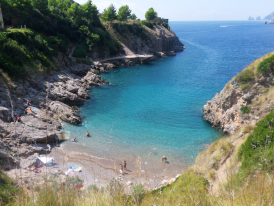
Trail to Baia di Ieranto with crystal clear waters below
Marina della Lobra: Compact Fishing Village Reality
Marina della Lobra in Massa Lubrense stays genuine because it's built for boats and neighbors, not tour buses. This compact fishing village includes a sanctuary above the harbor and rocky swim entries that require local knowledge to navigate safely.
The fishing activity here remains real, with morning arrivals and afternoon boat maintenance creating the rhythms that define authentic coastal life.
When I bring groups here, the conversations with local fishermen often reveal family fishing traditions spanning generations, plus practical knowledge about seasonal catches and traditional boat building that you won't find in any guidebook.
Quick tip: Morning visits catch the fishing activity; afternoon works better for swimming in calm conditions.
What Are Sorrento's Best Nature and Outdoor Gems?
Access friction filters the crowds; bring hiking shoes and expect to work for these views.
Fiordo di Crapolla: Dramatic Inlet Worth the Effort
Most visitors take boat trips to overcrowded grottos, but Fiordo di Crapolla in Torca (Massa Lubrense) offers a dramatic inlet with ruins of a tiny chapel, accessed only by steep trail and long steps from Torca.
This crowd-thinning hike has the real fisherman vibe that most coastal spots have lost to tour boats.
The descent is legitimate work, requiring good shoes and reasonable fitness, but that's exactly why it stays serene.
You'll find crystal clear waters in a narrow fjord-like inlet, ancient chapel ruins built into the rock, and the kind of untouched coastal drama that explains why locals still make this effort.
Quick tip: Early morning hikes beat the heat; the trail is steep both ways, so plan accordingly.
Baia di Ieranto: Hike-Only Reserve with Marine Biology Programs
Baia di Ieranto isn't exactly secret anymore, but the hike-only access (40-50 minutes) and complete lack of services keep it genuinely serene. This FAI-managed reserve runs eco-activities including kayaking and snorkeling with marine biologists, offering educational depth beyond just swimming.
The trail winds through ancient olive groves that connect directly to Sorrento's agricultural heritage.
No facilities mean bring everything you need, but the protected status ensures this bay represents what the entire coast looked like before tourism development.
When I get the chance to host hiking groups here, the marine biology programs often reveal underwater archaeological remains and endemic species that most visitors never learn about otherwise.
Quick tip: Book WWF eco-activities in advance; the reserve limits daily access numbers.
Punta Campanella Trail: Ancient Via Minerva to the Lighthouse
The coastal ridge walk from Termini along the ancient Via Minerva to the lighthouse and tower delivers big views of Capri with far fewer day-trippers than the famous Path of the Gods.
This route follows genuine Roman road fragments, connecting you to centuries of coastal navigation history.
The trail offers dramatic clifftop perspectives, lighthouse access, and medieval tower ruins, all with significantly less crowding than Instagram-famous alternatives.
The walk takes about 2 hours round trip with moderate difficulty. It might be a tough one to take on while on vacation, but I think it's very much worth it.
Quick tip: Check lighthouse opening hours; the tower provides the best panoramic viewpoint.
Imagine Experiencing This City for Real
A local can show you Sorrento's vibe, flavors, and hidden gems up close.
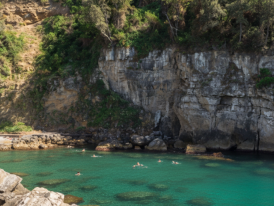
People swimming at Bagni Regina Giovanna
Spiaggia la Pignatella: Locals' Rocky Ledges
Between Puolo and Capo di Sorrento, these rocky platforms serve as locals' ledges for sunning and swimming.
No frills, no services, just functional coastal access that requires reef shoes and acceptance that comfort isn't the priority.
What you get is authentic local beach culture without any commercial overlay, beautiful waters for swimming, and the kind of unpretentious coastal experience that's increasingly rare along this developed coastline.
If, for some reason, this spot doesn't do it for you, consider stopping by Bagni Regina Giovanna. It's a lovely alternative, in my humble opinion.
Safety Note: Cala di Mitigliano, often pitched as a "secret" cove, currently has a trail closure advisory for a collapsed section on the Termini access. Do not attempt until the Pro Loco lifts the warning.
Quick tip: Bring reef shoes for rocky entry; this is pure function over comfort.

Limoncello bottles at Giardini di Cataldo
What "Fake Gems" Should You Actually Skip or Tweak?
Not everything needs avoiding, but here's how to approach over-hyped spots.
Tourist Trattorie in Centro Storico: Keep, Tweak, or Try Alternatives
Keep: The atmosphere and convenience of dining in the old town.
Tweak: Research beyond the first restaurant with English menus and photos of dishes. Look for places where locals actually eat, not just pass by.
Alternative: Head to Piano di Sorrento or Marina Grande for family trattorie that serve locals first, tourists second. The quality difference is significant, and you'll experience actual Italian dining culture instead of performed versions.
Marina Piccola Lounges for "Nightlife": Keep, Tweak, or Try Alternatives
Keep: The waterfront location and sunset drinks.
Tweak: Go for aperitivo hour (18:30-20:00) then move on instead of expecting Miami-style nightlife.
Alternative: Embrace the Italian evening passeggiata (leisurely walk) followed by gelato, or check our guide for things to do at night in Sorrento for local bars at where fishing families actually gather.
Tourist Limoncello Shops: Keep, Tweak, or Try Alternatives
Keep: The convenience of central shopping locations.
Tweak: Avoid the theatrical tasting rooms that prioritize entertainment over quality.
Alternative: Visit Giardini di Cataldo for artisanal production, or ask locals about homemade bottles – many families still make their own and occasionally sell to neighbors.
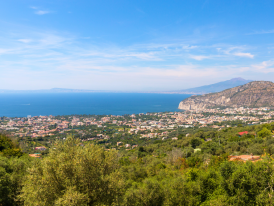
Panoramic view from Sant’Agata sui Due Golfi belvedere
What Practical Tips Help You Navigate Like a Local?
Timing beats everything else when it comes to moving around what Sorrento offers like you live here.
Clustering Your Days by Geography
We like to group our Sorrento activities by coast versus hills.
Marina Grande, Marina Piccola, and Bagni della Regina Giovanna work well on the same coastal day.
Sant'Agata and Massa Lubrense combine for hill views and inland dining.
Piano di Sorrento and Sant'Agnello pair for authentic neighborhood culture and Sunday lunch traditions.
When planning your route, remember that Piazza Tasso serves as the natural hub for most walking routes, connecting the old town to marina access points and main shopping along Corso Italia.
This clustering saves time, reduces transfer costs, and matches how locals actually move around their town.
Instead of zigzagging across Sorrento chasing individual attractions, you'll flow naturally through connected experiences.
Timing Beats Everything
Markets run on morning schedules, Mercato Comunale fills early with folks buying fresh fish and produce, then quiets by noon.
Aperitivo culture runs 18:30-20:00 before late dinners. Beach access works best early in high season, while museums and the cloister shine during afternoon hours when coastal spots get crowded.
When I plan routes for visitors, timing matters more than distance. A perfectly timed day flows with local rhythms instead of fighting them.
Step-Free Options and Access Reality
Villa Comunale and the Cloister of San Francesco are broadly step-free and accessible. Museo Correale has good internal access once you're there.
However, marina areas and natural pools like Bagni della Regina Giovanna involve uneven paths, steep descents, or rocky access that's not suitable for mobility issues.
Plan accordingly, Sorrento's charm often involves ancient streets and natural coastlines that weren't designed for universal access.
Cash vs. Card and Booking Friction
Smaller family trattorie, especially in Piano di Sorrento and some Marina Grande spots, operate primarily on cash and prefer payment in euros rather than cards.
For weekend reservations at seaside restaurants, book during the week of your visit rather than months in advance, as many authentic local favorites work on Italian timing rather than international planning schedules.
Seaside restaurants in summer require reservations made the week of your visit.
Quick tip: Always carry cash for authentic local dining; book seaside restaurants the week of your visit, not months ahead.
A Quick Local Lens: Saints, Sea and the Valley
Ask any nonna about Sorrento's patron saint and she will point you to Sant’Antonino, protector of sailors and fishermen whose stories are tied to the sea.
Walk a few minutes and peer into the valley of Vallone dei Mulini, a mossy valley that reminds you this town once ran on waterwheels, not selfies.
At golden hour the cloister and Villa Comunale become the perfect place to feel both histories at once, with church bells on one side and the bay on the other.
If you still need reasons to visit Sorrento after reading this, I suggest you just come on over and see my city for yourself already.
Experiences Created by Locals, Just for You
See Sorrento through the eyes of the people who call it home.
Frequently Asked Questions
1) Is Marina Grande Actually a Tourist Trap?
This is absolutely not a tourist trap, it's a working fishing village where tourists are welcome but not the primary focus. The key is understanding local usage: weekend lunch culture, simple preparations focused on whatever fish came in that morning, and acceptance that waterfront dining costs more everywhere in Italy. If you approach it like we do (slow meals, fresh catch, family atmosphere), it's authentically excellent.
2) Where Can You Find Real Leather Goods?
Sorrento's famous for leather work, but most souvenir shops sell mass-produced items. For beautiful leather goods, ask for family workshops still operating in the old town's back streets, or head to Piano di Sorrento's artisan shops. Real Sorrentine leatherwork focuses on quality over tourist-friendly pricing.
3) What's the Best Way to Visit the Blue Grotto from Sorrento?
The Blue Grotto trip from Sorrento involves a ferry to Capri, then a boat transfer, then a tiny rowboat into the grotto itself where tickets are purchased on site. Local tip: summer crowds make this an all-day commitment with significant waiting. Shoulder seasons offer better timing, and booking through local operators who understand weather conditions beats international tour companies. If the swell's up, I skip it. I don't queue for a maybe.
4) Can You Actually Access Fiordo di Crapolla Year-Round?
This spot requires a steep trail and long steps from the village, but it's accessible year-round with proper footwear and reasonable fitness. The dramatic inlet with chapel ruins offers genuine crowd-thinning access friction that keeps it serene even in summer. Winter visits provide solitude, but check weather conditions for safe descent on wet rocks.
5) Is Marina di Cassano Worth the Cliff Descent?
The tuff-cliff location requires either stairs or seasonal lift access, but the working marina atmosphere with carved boat houses and volcanic sand beach justifies the effort. The shipbuilding heritage and family lidos create authentic local culture that's increasingly rare along the developed coastline. Lift operates seasonally, stairs are always available.
6) What Makes Villa Fondi De Sangro Different from Tourist Museums?
It functions as local civic space, hosting civil weddings and community events rather than targeting tour groups. The Bronze Age through Roman archaeological finds provide regional context, while the clifftop park offers peaceful bay views without crowds. This dual civic and cultural function keeps it genuinely local-first.
7) How Do You Book Caseificio "Il Turuziello" Experiences?
The mozzarella-making demos at Caseificio "Il Turuziello" in Schiazzano work best through small-group food tours that include PGI lemon grove context. The rural setting and low tourist churn maintain authentic farm atmosphere, but advance booking ensures availability. The experience connects dairy traditions with agricultural landscape understanding.
8) Is Punta Campanella Trail Actually on Ancient Roman Roads?
Yes, the trail from Termini follows genuine fragments of the ancient Via Minerva, connecting coastal navigation history with modern hiking. The Roman road sections are visible and documented, leading to the lighthouse and medieval tower. This historical authenticity distinguishes it from purely scenic coastal walks, offering cultural depth beyond just views.
9) How Far Is Sorrento from Naples, Pompeii, and Mount Vesuvius?
Sorrento sits about an hour by train from Naples, making it a perfect base for day trip exploration. Pompeii is roughly 30 minutes by train, while Mount Vesuvius requires combining train travel to Pompeii with a bus transfer to the volcano base. Locals treat Sorrento as their home base for exploring the entire Bay of Naples area, the train connections are reliable and frequent.
10) Is Sorrento Part of the Amalfi Coast?
Technically, Sorrento anchors the northern end of the Sorrentine Peninsula, while the famous Amalfi Coast towns (Positano, Amalfi, Ravello) stretch along the southern shore. But most visitors use Sorrento as their base for Amalfi Coast day trips, it's less crowded, better connected by public transport, and offers more authentic local life than the resort-focused coastal towns.
11) What Makes a Perfect Day Trip from Sorrento?
I start early or I don't go, that's the whole trick. Perfect day trips from Sorrento include the ferry journey to Capri for island exploration, train connections to Naples for urban culture and pizza, or driving the coastal road to Positano and Amalfi for classic Mediterranean scenery. Sorrento works as a great base because locals recommend starting early, bringing cash for small venues, and accepting that Italian timing runs slower than tourist schedules.
12) How Do You Taste Authentic Local Cuisine in Sorrento?
Local cuisine in Sorrento goes beyond lemons and tourist menus. Focus on fishing culture at Marina Grande, family trattorie in Piano di Sorrento for Sunday lunch traditions, and Sant'Agata for proper gnocchi alla sorrentina. Locals eat late (never dinner before 20:30), embrace slow multi-course meals, and value seasonal ingredients over Instagram-worthy presentations.
13) Where Can You Experience Real Italian Summer Culture?
This time in Sorrento centers on evening passeggiata (leisurely walking), late dinners with multiple courses, gelato as a daily ritual, and family gatherings that span generations. Join the evening walk along Corso Italia, time your dining with local schedules, and understand that summer social life happens outdoors from sunset until late night.
14) What Are the Best Sunset Spots Locals Use?
Villa Comunale Park offers the most accessible sunset viewing with benches perfect for the golden hour experience, while the belvedere at Sant'Agata provides dramatic panoramic views requiring a short drive. Locals often combine sunset with aperitivo culture, enjoying a limoncello spritz at the quieter edges of Piazza Tasso while watching the light change over the bay. The key is timing your arrival 30 minutes before sunset for the full color show.
15) Can You See All These Hidden Gems in One Visit?
Attempting all the elements of Sorrento's secrets in a single visit misses the point, these truer 2025 spots require access friction and local knowledge, not tourist checklist mentality. Locals experience their town seasonally, socially, and slowly. Choose 2-3 gems per day based on hiking ability and weather conditions, embrace Italian timing, and understand that the perfect way to visit Sorrento involves slowing down, not speeding up.
Why Sorrento's Daily Life Beats Any Postcard
After years of exploring this town from my Naples perspective and countless hours hosting visitors through these limestone streets, I've learned that the genuine secret gems in Sorrento aren't hiding at all.
They're simply lived.
The fishing boats at Marina Grande matter more than their photogenic qualities. The family mozzarella-making at Il Turuziello reveals more about agricultural traditions than any tour.
The evening passeggiata along Villa Comunale connects you to centuries of Mediterranean social traditions.
Sure, these hidden gems require effort, whether that's hiking down to Fiordo di Crapolla's dramatic inlet, taking stairs to Marina di Cassano's working boathouses, or booking ahead at family farms in Massa Lubrense.
So many things make Sorrento special, but the complete picture only emerges when you stop searching for secrets and start participating in the 'normal things.'
Italy experiences reward visitors who embrace local timing, respect neighborhood etiquette, and understand that the best travel experiences aren't performed for tourists, they're shared with locals who happen to welcome curious outsiders into their genuine way of life.
More Sorrento Adventures
Ready to plan your perfect day in Sorrento?
Start your experienceTravel Guides Can Only Take You So Far
City Unscripted connect travelers with locals who shape days that actually fit your interests, not someone else’s checklist.
Wish you had a local friend in Sorrento?
One who knows the city inside out and could plan a private day just for you? Our local hosts do exactly that: no scripts, no tourist traps, just the side of the city most people miss.
